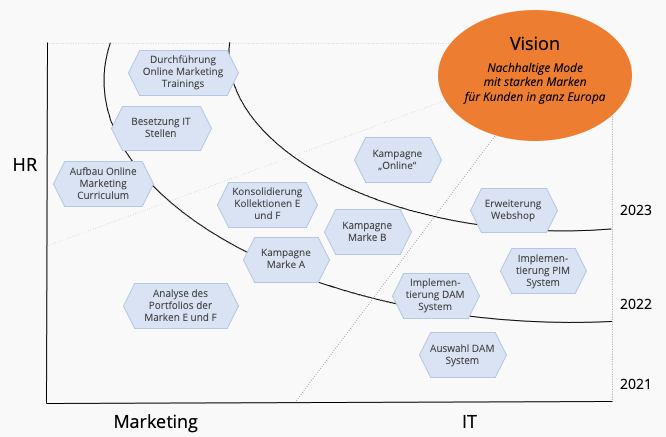Specification of a strategy for successful implementation
In the second part of our series on strategy creation, we dealt with how you can start concretizing your strategy based on the vision and mission as well as the environment and self-analysis. Building on that, let’s take a closer look at how you can flesh out the strategy .
From actual to target
The strategy aims to transform the company from the current state to a future state . If you have already followed the first two posts in our series, you have already defined it with the help of vision and mission.
If you now look at the current situation of your company, you will find that adjustments are necessary in various areas in order to achieve the set goal. The previously performed environment and SWOT analyzes will also help you. With their help, you can assess where adjustments are necessary.
The following section is intended to illustrate this using an example:
Example – A fashion manufacturer
As a fashion manufacturer with a business model that has so far been heavily focused on retail, you want to play a leading role in online retail in the future. In accordance with your vision, you want to become the most-worn brand in Europe with sustainably produced fashion.
Your company has several well-known brands in its portfolio and is well positioned in terms of production and logistics. This has already put you at the forefront of market shares in several countries.
However, you have weaknesses when it comes to online presence. Furthermore, the increasing change to online business represents a high risk for your current business.
As you can see from the environment analysis, your competitors in online trading have increased their sales considerably in recent years. In terms of brand awareness, however, they lag far behind your company. However, your brands are losing ground in customer perception compared to those of the competition.

The online strategy is to be specified
Strategic fields of action in the case of the fashion manufacturer
The factors mentioned above already result in a number of fields of action that need to be tackled in order to achieve the vision.
In marketing , the existing brands need to be modernized. This can also mean that individual brands are removed from the portfolio in order to focus on more promising ones.
In addition, the marketing channels must be coordinated with increasing online business. This also requires that the IT systems are provided to manage the goods and marketing materials digitally and to play them out in different channels. This can be done, for example, using a digital asset management system (DAM).
At the same time, new skills are required from employees. The HR department will provide training courses to ensure that marketing staff become more familiar with the needs of online business. New hires are made in IT for the provision and operation of new systems.
Strategic Goals
In the next step, you define strategic goals for the specified fields of action. These goals are intended to determine what is to be achieved specifically in the fields of action for the strategy’s observation period (3-5 years).
For the fashion manufacturer example, these could be:
| field of action | Strategic Goals |
| HR – building online skills |
|
| IT – Technological basis for online business |
|
| Marketing – modernization of brands |
|
| Marketing – focus on online channels |
|
Be sure to define the goals SMART :
- Specific – the goal should be specific
- Measurable – the goal is defined quantitatively and/or qualitatively using defined measurement parameters
- Attractive – the participants should have an interest in achieving the goal
- Realistic – the goal should be achievable within the given timeframe with the available resources
- Time- bound – specify the time when the goal is to be achieved
In this context, the OKR method should also be mentioned, which has gained enormous popularity in recent years.
With their help, the goals (objectives) are operationalized via concrete results to be achieved (key results). Implementation is then monitored and controlled by regular reviews of target achievement. This review can take place, for example, once a quarter. Visit our Knowledge Base for more information on this and other methods.
road map
After you have defined the strategic goals, you define the activities that are necessary to get from the current starting point to the desired target state. This often results in dependencies in terms of content or time. In addition, you will probably plan with limited resources that need to be coordinated.

Roadmap for the concretization of the strategy
You then arrange the activities according to their priorities and the dependencies mentioned. You then map these as shown above for each field of action on a roadmap diagram . This then defines your company’s path to achieving your goals.
The roadmap then serves as the basis for project portfolio management . In it, you define the relevant initiatives, provide them with budgets and monitor their implementation. This creates the transition to a successful and sustainable implementation of your strategy.
In real life, strategy is actually very straightforward. You pick a general direction and implement like hell.
— Jack Welch
Conclusion
The concretization of the strategy is a crucial step in the creation of the strategy . If you don’t do this, strategies are often too vague and not applicable in everyday work. In many cases, employees then perceive the strategy as “too aloof”. In many cases, this is followed by the fact that they completely ignore the strategy (according to the motto “again a new strategy, but nothing changes anyway”).
Hence our advice: Define your strategy based on a motivating vision and mission , strategic goals and concrete initiatives for the coming months and years. Then you have an excellent tool to lead your company successfully into the future. You can create this basis with the help of the ConWISE platform. Contact us.


